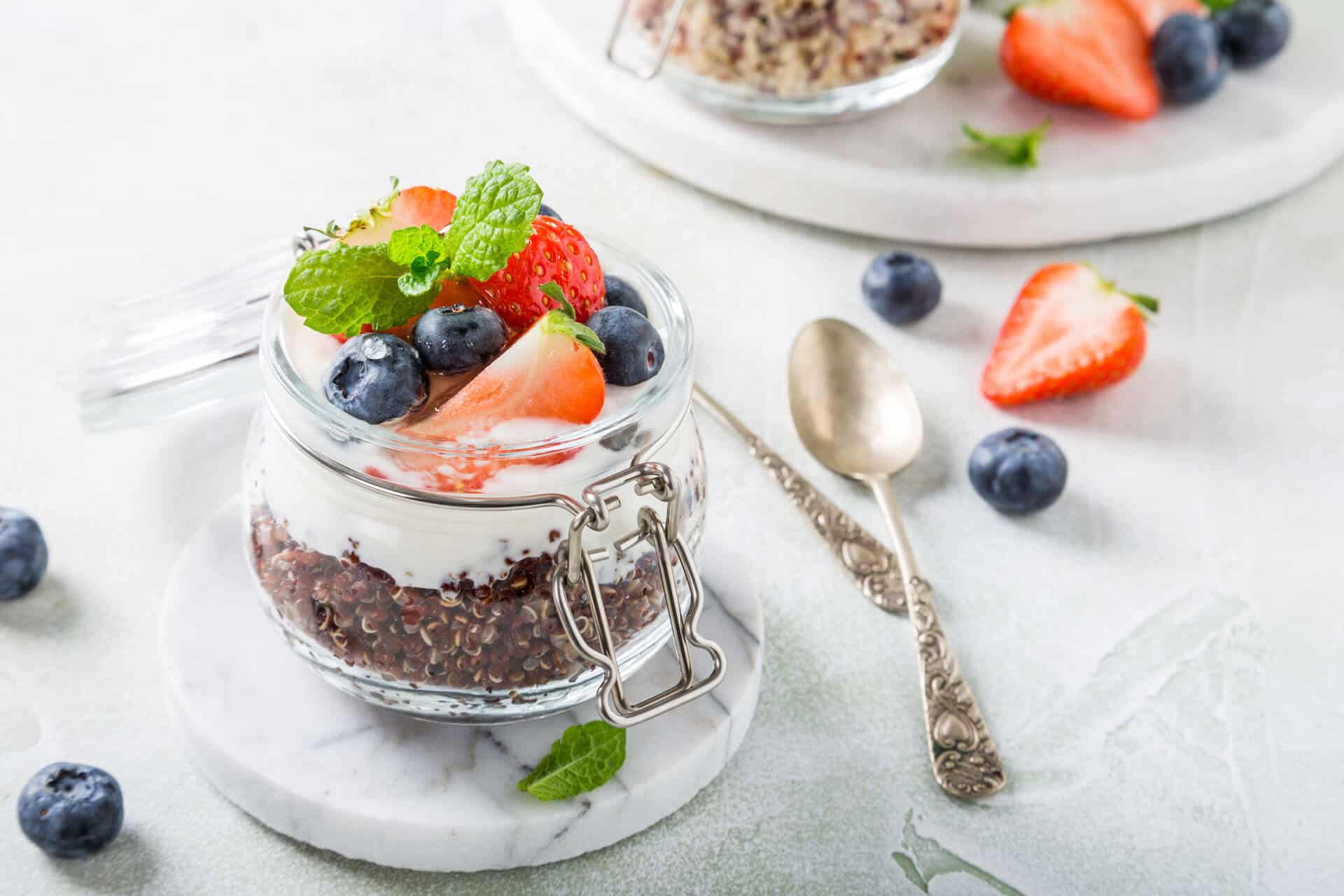Eating a gluten-free diet doesn’t have to be hard. In fact, a gluten-free diet is similar to a traditionally healthy diet filled with vegetables, fruits, fish, and meat.
If you love your grains, you can still eat them too, as there are many wholesome grains free of gluten. The key is knowing what to look for and what to avoid.
In this guide, we’ll provide a comprehensive list of gluten-free foods and share some helpful tips you can use to make your transition to a gluten-free diet easier.
Gluten-Free Foods
Whole Grains
Most whole grains are gluten-free, but there are a few exceptions to watch out for.
It’s also important to closely check nutrition labels when purchasing whole grains as even gluten-free grains can be contaminated with gluten if they are processed in the same facility as foods with gluten.
An example is oats, that are often processed in the same facility as wheat, which can result in cross-contamination. Because of this, you want to make sure the oats you buy are certified gluten-free.
Gluten-free whole grains
- Brown rice
- Quinoa
- Tapioca
- Millet
- Wild rice
- Buckwheat
- Sorghum
- Arrowroot
- Oats
- Amaranth
- Teff
Grains to avoid
- Wheat, all varieties (whole wheat, wheat berries, graham, bulgur, farro, farina, durum)
- Rye
- Barley
- Triticale
These gluten-containing grains are common ingredients in products like bread, pasta, cereals, and snack foods.
Fruits and Vegetables
Fresh fruits and vegetables are naturally gluten-free, however, some processed fruits and vegetables contain gluten, which is sometimes added for flavoring.
Some ingredients with gluten that may be added to processed fruits and vegetables include modified food starch, hydrolyzed wheat protein, malt, and maltodextrin.
Gluten-free fruits and vegetables
Here is a list of some of the different fruits and vegetables you can enjoy on a gluten-free diet.
- Apples
- Citrus fruits, including oranges and grapefruit
- Bananas
- Berries
- Peaches
- Pears
- Carrots
- Cruciferous vegetables, including cauliflower and broccoli
- Greens, such as spinach, kale, and Swiss chard
- Green beans
- Bell peppers
- Starchy vegetables, including potatoes, corn, and squash
- Mushrooms
- Onions
- Radishes
Here are some of the fruits and vegetables that you’ll want to double-check as they could be processed with gluten-containing ingredients.
- Canned fruits and vegetables
- Frozen fruits and vegetables
- Dried fruits and vegetables
- Pre-chopped fruits and vegetables
Fats and Oils
Fats and oils are naturally gluten-free but there are cases where gluten-filled additives may be added for flavor or thickening.
Gluten-free fats and oils
- Butter
- Avocados and avocado oil
- Coconut oil
- Olives and olive oil
- Vegetable and seed oils, including sesame oil, canola oil, and sunflower oil
- Ghee
Double-check the following items to ensure that they are gluten-free.
- Cooking sprays
- Oils with added flavors
Dairy Products
Most dairy products are gluten-free but you should always double-check flavored varieties as they may have additives that contain gluten.
Gluten-free dairy products
- Butter and ghee
- Cheese
- Milk
- Cottage cheese
- Cream
- Sour cream
- Yogurt
Be sure to double-check the following products to ensure that they do not have gluten-containing ingredients.
- Flavored milks and yogurts
- Ice cream
- Processed cheese products, such as cheese sauces and spreads
Proteins
While most protein sources are gluten-free, gluten-containing ingredients such as soy sauce, flour, and malt vinegar are often used as flavorings or fillers. These could be added to sauces, rubs, and marinades that are paired with protein sources.
You’ll want to look out for them when looking for gluten-free protein.
Gluten-free proteins
- Poultry such as fresh chicken, turkey
- Red meat such as fresh beef, pork, lamb, bison
- Seafood such as fresh fish, scallops, shellfish
- Legumes such as beans, lentils, peas, peanuts
- Nuts and seeds
- Traditional soy foods such as tofu, tempeh, edamame
You’ll want to double-check the following proteins to ensure they are gluten-free.
- Ground meats
- Proteins that have been combined with sauces or seasonings
- Processed meats, like hot dogs, pepperoni, sausage, salami, and bacon
- Lunch meats or cold cuts
- Meat substitutes
- Ready-to-eat proteins, like those in microwavable TV dinners
Proteins to avoid
- Any meat that has been breaded
- Proteins that are combined with wheat-based soy sauce
- Seitan
Beverages
There are many gluten-free beverages you can enjoy but there are some beverages mixed with additives that contain gluten.
Also, alcoholic beverages made with malt, barley, other gluten-filled grains should be avoided.
Gluten-free beverages
- Water
- Coffee
- 100% fruit juice
- Sports drinks
- Tea
- Some alcoholic beverages, including those made from gluten-free grains
- Soda and energy drinks
- Lemonade
Be sure to double-check the following beverages to ensure they gluten-free.
- Any beverage with added flavorings or mix-ins
- Distilled liquors such as vodka and whiskey
Beverages to avoid
- Beers, ales, and lagers made from gluten-containing grains
- Non-distilled liquors
- Malt beverages like wine coolers
Sauces and Spices
Sauces and spices are often overlooked in a gluten-free diet but are very important to keep in mind.
Like other foods, most sauces and spices are naturally gluten-free but sometimes have gluten-containing ingredients added to them to enhance flavor.
Gluten-free sauces and spices
- Coconut aminos
- Tamari
- White vinegar, distilled vinegar, and apple cider vinegar
Here are some of the sauces and spices you’ll want to double-check to ensure they are gluten-free.
- Ketchup
- Mayonnaise
- Worcestershire sauce
- Pasta sauce
- Tomato sauce
- Relish and pickles
- Barbecue sauce
- Mustard
- Salad dressing
- Dry spices
- Salsa
- Gravy and stuffing mixes
- Stock and bouillon cubes
- Marinades
- Rice vinegar
Eating Gluten-Free at Restaurants
To maintain your gluten-free diet while eating at restaurants, you’ll need to get comfortable asking a lot of questions. For instance, if you have a salad, the available dressings could have gluten. You’ll want to ask if it is bottled or made in-house. If it is made in-house, ask what is in the ingredients.
Gluten-free menus are helpful but can be unreliable at times. You want to make sure that foods are not cooked in a manner susceptible to cross-contamination. For example cooking pancakes on the same griddle as eggs.
Some helpful questions you may need to ask include, are fries dunked in the same oil that floured chicken fingers were? Do they cook the gluten-free pasta in the same water as the regular pasta?
Your server should be happy to answer any questions so do not feel bad about wanting to learn more about the food.
Gluten-Free Baked Goods From Outrageous Baking
Outrageous Baking can help you maintain your gluten-free diet while still indulging in your favorite baked goods (without the guilt).
We offer a variety of gluten-free and dairy-free treats that taste just like your mom’s homemade recipes. From cinnamon coffee cake to pumpkin or chocolate zucchini bread, our gluten-free breads and cakes are a true delight. Visit our store today to find delicious gluten-free treats that your entire family will enjoy in good health!


